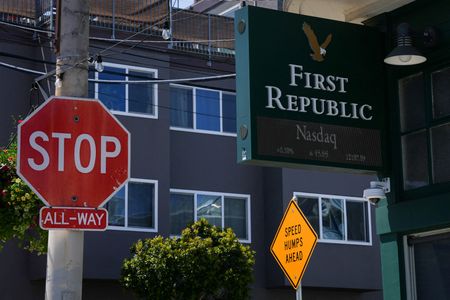
(Reuters) – JPMorgan Chase & Co is buying most of First Republic Bank’s assets, which had been seized by United States regulators, in a last-ditch rescue for the strained lender, marking the third major U.S. bank to fail in two months.
Last week, First Republic reported a more than $100 billion plunge in deposits in the first quarter that sparked a brutal sell-off in the lender’s shares.
Banks have been staring at the biggest crisis since 2008 after two U.S. lenders collapsed in March and the turmoil has ratcheted up fears of a contagion and prompted action from the U.S. Federal Reserve, U.S. Treasury and the private sector.
Below is a timeline of key events:
Date Development
March 8 Crypto-friendly bank Silvergate Capital Corp says
it would wind down operations and voluntarily
liquidate.
Silicon Valley Bank (SVB) says it intends to raise
$2.25 billion in common equity and preferred
convertible stock.
March 9 The S&P 500 bank index tumbles following SVB’s
announcement and crypto bank Silvergate’s decision
to wind down operations. SVB stock collapses by
60%, leading the company to scramble to reassure
its clients their money was safe.
March 10 A California regulator shuts SVB and appoints the
Federal Deposit Insurance Corporation (FDIC) as
receiver. U.S. bank stocks extend losses with
regional lenders hit the hardest.
U.S. lenders First Republic Bank and Western
Alliance say their liquidity and deposits remained
strong, aiming to calm investors worried of a
spill-over.
SVB CEO Greg Becker leaves the board of directors
at the Federal Reserve Bank of San Francisco.
March 11 The U.S. Federal Reserve and the FDIC weigh the
creation of a fund that would allow regulators to
backstop more deposits at banks, Bloomberg News
reported.
March 12 Yellen says she is working closely with banking
regulators to respond to the SVB collapse. U.S.
officials later say SVB customers will have access
to their deposits.
New York state’s Department of Financial Services
takes possession of New York-based Signature Bank.
March 13 HSBC acquires the UK subsidiary of Silicon Valley
Bank for 1 pound.
The FDIC says it has transferred all deposits of
SVB to a newly created bridge bank.
U.S. President Joe Biden says the administration’s
actions should give Americans confidence that the
banking system is safe.
Western Alliance Bancorp says more than 50% of its
total deposits were insured and it has over $25
billion of cash reserves. Shares of U.S. regional
banks slump, led by First Republic, while credit
risk indicators flash red as investors worry about
contagion risks.
March 14 Moody’s Investors Service revises its outlook on
the U.S. banking system to “negative” from
“stable”, citing heightened risks.
U.S. prosecutors investigate the collapse of SVB,
a source familiar with the matter told Reuters.
March 15 Troubled Swiss giant Credit Suisse says it will
strengthen its liquidity by borrowing from the
Swiss National Bank up to 50 billion Swiss francs
($54 billion).
March 16 Yellen tells a U.S. Senate hearing that uninsured
deposits would only be guaranteed in banks deemed
a contagion threat, raising fears about smaller
banks.
Large U.S. banks inject $30 billion in deposits
into First Republic Bank to shore up the lender’s
finances.
March 17 SVB Financial Group files for Chapter 11
bankruptcy protection.
March 18 UBS is examining a takeover of Credit Suisse that
could see the Swiss government offer a guarantee
against the risks involved, say two people with
knowledge of the matter.
March 19 UBS agrees to buy Credit Suisse for 3 billion
Swiss francs in stock and agrees to assume up to 5
billion francs in losses.
March 20 The FDIC decides to break up SVB and hold two
separate auctions for its traditional deposits
unit and its private bank after failing to find a
buyer for the lender.
March 21 U.S. Treasury Secretary Janet Yellen tells bankers
that she is prepared to intervene to protect
depositors in smaller U.S. banks.
Reuters reports, citing sources, that First
Republic is looking at ways it can downsize if its
attempts to raise new capital fail
March 22 Yellen tells lawmakers that she has not considered
or discussed “blanket insurance” to U.S. banking
deposits without approval by Congress, again
stirring up investor worry. Federal Reserve Chair
Jerome Powell says SVB’s failure is not indicative
of wider weaknesses in the banking system.
March 27 First Citizens BancShares Inc says it would
acquire the deposits and loans of failed Silicon
Valley Bank.
April 24 First Republic shares sink after reporting
deposits plunged by more than $100 billion in the
first quarter and that it was exploring options
such as restructuring its balance sheet.
April 25 First Republic faces dwindling and tough options
to turn around its business with the creation of a
‘bad bank’ or asset sales possibilities, a source
tells Reuters.
April 26 First Republic advisers have already lined up
potential purchasers of new stock in the lender if
they can fix the bank’s balance sheet, CNBC
reports citing sources
April 28 The FDIC is prepared to place First Republic under
receivership imminently, a source says.
U.S. officials coordinate urgent talks to rescue
First Republic as private-sector efforts led by
the bank’s advisers yet to reach a deal, three
sources tell Reuters.
April 29 U.S. regulators try to clinch a sale of First
Republic Bank over the weekend, with roughly half
a dozen banks bidding, sources tell Reuters.
April 30 PNC Financial Services Group, JPMorgan Chase and
Citizens Financial Group Inc among banks that
submitted final bids for First Republic, according
to sources.
May 1 U.S. regulators say First Republic Bank has been
seized and a deal agreed to sell the bank’s assets
to JPMorgan Chase & Co.
Sources: company statements, press conferences, media reports
(Reporting by Mehnaz Yasmin amd Manya Saini in Bengaluru; Editing by Devika Syamnath and Krishna Chandra Eluri)

